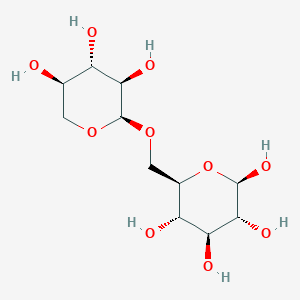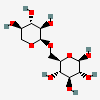beta-Isoprimeverose
PubChem CID
56625777
Molecular Formula
Synonyms
- 6-O-alpha-d-xylopyranosyl-beta-d-glucopyranose
- beta-Isoprimeverose
- Xyl(a1-6)b-Glc
- CHEBI:146431
- alpha-D-Xylp-(1->6)-beta-D-Glcp
Molecular Weight
312.27 g/mol
Computed by PubChem 2.1 (PubChem release 2021.05.07)
Dates
- Create:2012-02-25
- Modify:2025-01-18
Description
Alpha-D-Xylp-(1->6)-beta-D-Glcp is an alpha-D-Xylp-(1->6)-D-Glcp in which the carbon bearing the anomeric hydroxy group has beta configuration. The disaccharide unit of xyloglucan in plant cell-walls. It has a role as a plant metabolite. It is functionally related to an alpha-D-xylose and a beta-D-glucose.
Chemical Structure Depiction

SVG Image

IUPAC Condensed
Xyl(a1-6)b-Glc
LINUCS
[][b-D-Glcp]{[(6+1)][a-D-Xylp]{}}
IUPAC
alpha-D-xylo-pentopyranosyl-(1->6)-beta-D-gluco-hexopyranose
Permethylated Mass
Monosaccharide Composition
Hex1 Xxx1
(2R,3R,4S,5S,6R)-6-[[(2R,3R,4S,5R)-3,4,5-trihydroxyoxan-2-yl]oxymethyl]oxane-2,3,4,5-tetrol
Computed by LexiChem 2.6.6 (PubChem release 2019.06.18)
InChI=1S/C11H20O10/c12-3-1-19-11(9(17)5(3)13)20-2-4-6(14)7(15)8(16)10(18)21-4/h3-18H,1-2H2/t3-,4-,5+,6-,7+,8-,9-,10-,11-/m1/s1
Computed by InChI 1.0.5 (PubChem release 2019.06.18)
QYNRIDLOTGRNML-DRWRGJIVSA-N
Computed by InChI 1.0.5 (PubChem release 2019.06.18)
C1[C@H]([C@@H]([C@H]([C@H](O1)OC[C@@H]2[C@H]([C@@H]([C@H]([C@@H](O2)O)O)O)O)O)O)O
Computed by OEChem 2.3.0 (PubChem release 2024.12.12)
C11H20O10
Computed by PubChem 2.1 (PubChem release 2019.06.18)
- 6-O-alpha-d-xylopyranosyl-beta-d-glucopyranose
- beta-Isoprimeverose
- Xyl(a1-6)b-Glc
- CHEBI:146431
- alpha-D-Xylp-(1->6)-beta-D-Glcp
- alpha-D-xylo-pentopyranosyl-(1->6)-beta-D-gluco-hexopyranose
- WURCS=2.0/2,2,1/[a2122h-1b_1-5][a212h-1a_1-5]/1-2/a6-b1
- (2R,3R,4S,5S,6R)-6-[[(2R,3R,4S,5R)-3,4,5-Trihydroxyoxan-2-yl]oxymethyl]oxane-2,3,4,5-tetrol
Property Name
Property Value
Reference
Property Name
Molecular Weight
Property Value
312.27 g/mol
Reference
Computed by PubChem 2.1 (PubChem release 2021.05.07)
Property Name
XLogP3-AA
Property Value
-4.7
Reference
Computed by XLogP3 3.0 (PubChem release 2019.06.18)
Property Name
Hydrogen Bond Donor Count
Property Value
7
Reference
Computed by Cactvs 3.4.6.11 (PubChem release 2019.06.18)
Property Name
Hydrogen Bond Acceptor Count
Property Value
10
Reference
Computed by Cactvs 3.4.6.11 (PubChem release 2019.06.18)
Property Name
Rotatable Bond Count
Property Value
3
Reference
Computed by Cactvs 3.4.6.11 (PubChem release 2019.06.18)
Property Name
Exact Mass
Property Value
312.10564683 Da
Reference
Computed by PubChem 2.1 (PubChem release 2021.05.07)
Property Name
Monoisotopic Mass
Property Value
312.10564683 Da
Reference
Computed by PubChem 2.1 (PubChem release 2021.05.07)
Property Name
Topological Polar Surface Area
Property Value
169 Ų
Reference
Computed by Cactvs 3.4.6.11 (PubChem release 2019.06.18)
Property Name
Heavy Atom Count
Property Value
21
Reference
Computed by PubChem
Property Name
Formal Charge
Property Value
0
Reference
Computed by PubChem
Property Name
Complexity
Property Value
341
Reference
Computed by Cactvs 3.4.6.11 (PubChem release 2019.06.18)
Property Name
Isotope Atom Count
Property Value
0
Reference
Computed by PubChem
Property Name
Defined Atom Stereocenter Count
Property Value
9
Reference
Computed by PubChem
Property Name
Undefined Atom Stereocenter Count
Property Value
0
Reference
Computed by PubChem
Property Name
Defined Bond Stereocenter Count
Property Value
0
Reference
Computed by PubChem
Property Name
Undefined Bond Stereocenter Count
Property Value
0
Reference
Computed by PubChem
Property Name
Covalently-Bonded Unit Count
Property Value
1
Reference
Computed by PubChem
Property Name
Compound Is Canonicalized
Property Value
Yes
Reference
Computed by PubChem (release 2019.01.04)
Follow these links to do a live 2D search or do a live 3D search for this compound, sorted by annotation score. This section is deprecated (see here for details), but these live search links provide equivalent functionality to the table that was previously shown here.
Same Connectivity Count
Same Parent, Connectivity Count
Similar Compounds (2D)
Similar Conformers (3D)
Same Count
- ChEBIAlpha-D-Xylp-(1->6)-beta-D-Glcphttps://www.ebi.ac.uk/chebi/searchId.do?chebiId=CHEBI:146431
- GlyGen
- Japan Chemical Substance Dictionary (Nikkaji)
- RCSB Protein Data Bank (RCSB PDB)LICENSEData files contained in the PDB archive (ftp://ftp.wwpdb.org) are free of all copyright restrictions and made fully and freely available for both non-commercial and commercial use. Users of the data should attribute the original authors of that structural data.https://www.rcsb.org/pages/policies
- Springer Nature
- Wikidataalpha-D-Xylp-(1->6)-beta-D-Glcphttps://www.wikidata.org/wiki/Q106054268
- PubChem
- Glycan Naming and Subsumption Ontology (GNOme)GNOme
- MolGenieMolGenie Organic Chemistry Ontologyhttps://github.com/MolGenie/ontology/
CONTENTS

